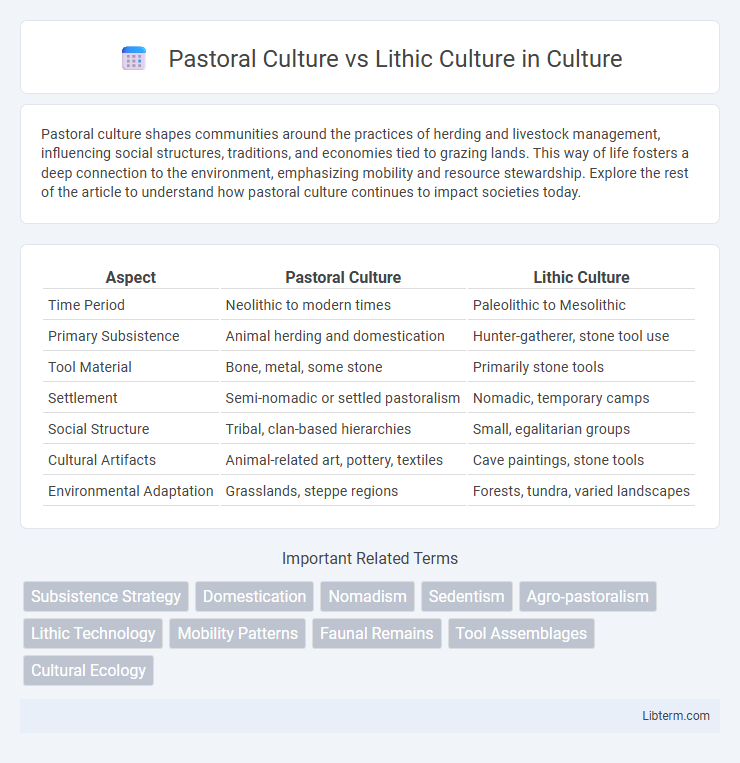Pastoral culture shapes communities around the practices of herding and livestock management, influencing social structures, traditions, and economies tied to grazing lands. This way of life fosters a deep connection to the environment, emphasizing mobility and resource stewardship. Explore the rest of the article to understand how pastoral culture continues to impact societies today.
Table of Comparison
| Aspect | Pastoral Culture | Lithic Culture |
|---|---|---|
| Time Period | Neolithic to modern times | Paleolithic to Mesolithic |
| Primary Subsistence | Animal herding and domestication | Hunter-gatherer, stone tool use |
| Tool Material | Bone, metal, some stone | Primarily stone tools |
| Settlement | Semi-nomadic or settled pastoralism | Nomadic, temporary camps |
| Social Structure | Tribal, clan-based hierarchies | Small, egalitarian groups |
| Cultural Artifacts | Animal-related art, pottery, textiles | Cave paintings, stone tools |
| Environmental Adaptation | Grasslands, steppe regions | Forests, tundra, varied landscapes |
Understanding Pastoral and Lithic Cultures
Pastoral culture centers on the domestication and herding of animals, which fosters social structures based on livestock management and seasonal migrations. Lithic culture emphasizes the use of stone tools and weapons, reflecting early human adaptation to environments through hunting, gathering, and tool-making techniques. Understanding these cultures involves analyzing archaeological evidence that highlights the technological advances, subsistence strategies, and ecological adaptations unique to each.
Origins and Historical Development
Pastoral culture originated around 10,000 years ago during the Neolithic period, characterized by the domestication of animals and a nomadic lifestyle centered on herding, primarily in regions like the Fertile Crescent and Central Asia. Lithic culture traces back to the Paleolithic era, over 2.5 million years ago, defined by the use of stone tools and hunter-gatherer subsistence across Africa, Europe, and Asia. The historical development of pastoral culture involved advancements in animal breeding and mobility, while lithic culture evolved through technological innovations in tool-making and adaptation to diverse environments.
Key Characteristics of Pastoral Societies
Pastoral societies are defined by their reliance on domesticated animals for subsistence, emphasizing herding and animal husbandry as primary economic activities. These societies typically exhibit nomadic or semi-nomadic lifestyles, moving livestock to access grazing lands and water resources. Social structures in pastoral cultures often revolve around kinship and clan systems, with communal ownership of herds playing a central role in economic and social organization.
Defining Features of Lithic Cultures
Lithic cultures are primarily defined by the extensive use of stone tools and weapons, reflecting early human technological development during the Paleolithic, Mesolithic, and Neolithic periods. These cultures exhibit hallmark traits such as flint knapping techniques, microlithic blade production, and a reliance on hunting and gathering, which contrast with the animal domestication and herd management central to pastoral societies. The preservation of lithic artifacts offers critical insights into early human adaptation and environmental interaction, emphasizing tool-making as a cornerstone of cultural evolution before the emergence of pastoralism.
Environment and Geographic Distribution
Pastoral cultures predominantly emerged in arid and semi-arid regions such as the steppes of Central Asia and the Sahara, where domesticated animals thrived on sparse vegetation. Lithic cultures developed primarily in diverse environments including forests, plains, and coastal areas, often evidenced by stone tools found across Africa, Europe, and Asia. Geographic distribution of pastoral societies is closely linked to grassland ecosystems, while lithic cultures display broader environmental adaptability due to their reliance on hunting and gathering.
Economic Practices: Herding vs Tool-Making
Pastoral culture emphasizes economic practices centered on herding domesticated animals such as sheep, goats, and cattle, facilitating a mobile lifestyle focused on grazing and animal husbandry. Lithic culture, in contrast, revolves around tool-making through the crafting of stone implements, which supports hunting, gathering, and early agricultural activities. The economic foundation of pastoralism relies on animal products like meat, milk, and wool, while lithic cultures depend on the extensive use of stone tools for subsistence and survival tasks.
Social Structure and Community Organization
Pastoral cultures typically develop hierarchical social structures centered around kinship ties and wealth accumulation through livestock, fostering cohesive, mobile communities with roles defined by herding and resource management. Lithic cultures, characterized by hunter-gatherer lifestyles, exhibit more egalitarian social organization with small, flexible bands focused on shared subsistence activities and minimal social stratification. These differences in social structure reflect adaptations to environmental resources, where pastoral societies emphasize territorial control and social status, while lithic groups prioritize mobility and communal decision-making.
Technological Advancements and Innovations
Pastoral Culture advanced animal domestication techniques, leading to the development of specialized tools such as herding sticks, milking pots, and portable shelters that supported nomadic lifestyles. Lithic Culture focused on the refinement of stone tool technology, pioneering innovations like flint knapping and the creation of diverse blade types for hunting, cutting, and scraping. The transition from lithic to pastoral societies marked a significant technological shift from solely stone-based tools to specialized implements enhancing animal husbandry and mobility.
Cultural Beliefs and Worldviews
Pastoral culture centers on animistic and totemic beliefs, emphasizing a deep spiritual connection with domesticated animals and natural cycles, reflecting a worldview that integrates human life with ecological stewardship. Lithic culture, rooted in hunter-gatherer societies, often embodies shamanistic traditions and reverence for ancestral spirits, highlighting a cosmology focused on survival, kinship, and the sacredness of the land. Both cultures illustrate distinct ways of understanding human existence through their unique rituals, myths, and environmental interactions.
Lasting Impacts on Human Civilization
Pastoral culture significantly contributed to the development of animal domestication, leading to advancements in agriculture and settlement patterns that shaped early human civilizations. Lithic culture pioneered tool-making techniques using stone, which enhanced hunting, gathering, and construction processes fundamental to human survival. Together, these cultures established foundational technologies and social structures that influenced economic systems, trade, and cultural evolution across diverse societies.
Pastoral Culture Infographic

 libterm.com
libterm.com